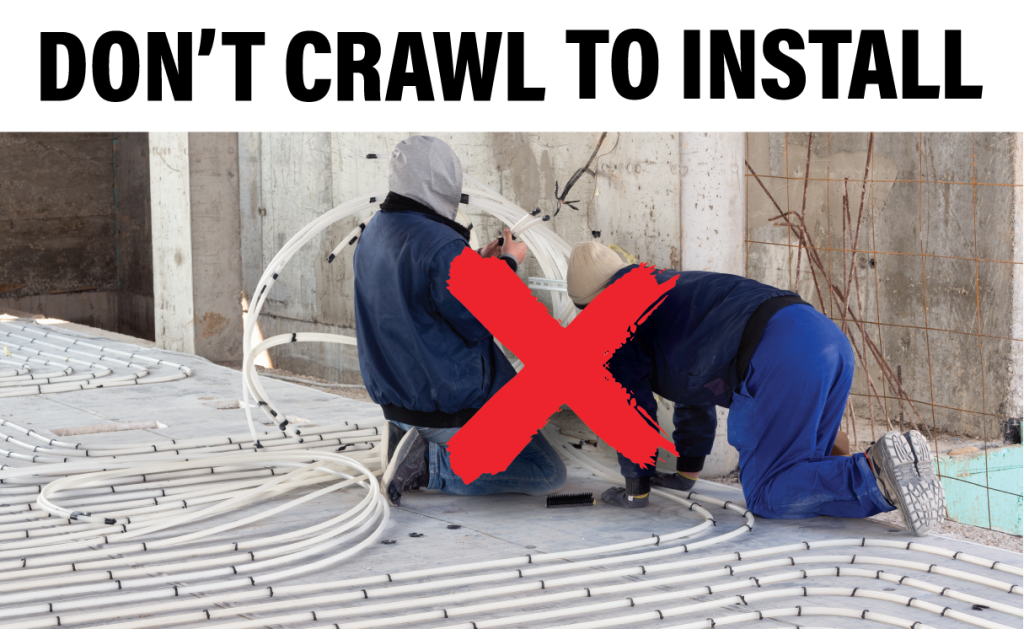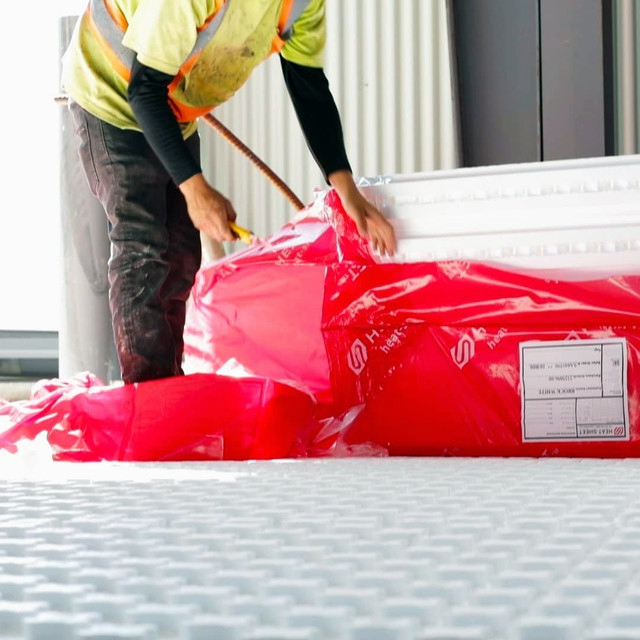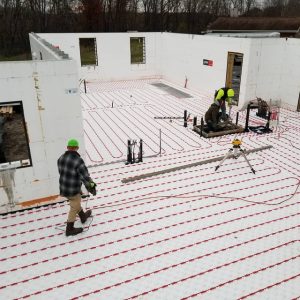Do you regularly install radiant floor tubing? Were you, or your crews, ever thrilled about an upcoming shift of laying pex piping?
As exciting as radiant heat flooring (RHF) is for homeowners, most installers who set these systems in place find this part of their work tedious, labor-intensive, and physically painful.
In this post, we will discuss Heat-Sheet’s RHF panels, and the tremendous advantage they offer in terms of comfort and installation speed.
First, let’s take an in-depth look at how HVAC installers set up RHF piping the slower, conventional way.
Conventional installation method
Hydronic RHF systems rely on a network of flexible tubes to circulate hot water beneath the floor they heat. This tubing must be fixed to the under-floor insulation. When flat XPS insulation is used to support the tubes, installers are forced to work on their hands and knees to secure the tubes to a flat surface.

The process looks something like this:
- Insulation panels are laid down.
- Inter-panel seams are taped.
- Installers get down on all fours to lay down the piping. Because regular, flat insulation can’t hold the piping in place by itself, the installers have to secure it with ties or staples.
- Installers tie or staple the piping to the insulation boards every 2 feet or so.
With this method, you can expect to install 5,000-6,000 lineal feet of tubing daily with a 3-4 person crew; this translates to about 1,600 linear feet per man, per day.
Not only is this old method inefficient and potentially sloppy, but it’s also agonizing for the crews. Imagine spending hours bent over or on your knees as you attach the tubing to insulation boards; based on the productivity calculation above, each laborer in your crew would be making 800 staples or ties daily! That’s enough to tire out a young, athletic laborer, let alone somebody in their forties or older. It’s no wonder that builders and HVAC installers are seldom thrilled about working on this scope.
Luckily, there’s an easier, handier, and quantifiably faster way to install pex tubing. Where flat insulation boards have no means of holding the tubes in place, Heat-Sheet boards are designed to do just that. Their channel grid allows for a multidirectional setup of piping; what’s more, the pipes can be walked in with the installer standing upright!

Don't miss a thing!
Subscribe for exclusive content, insider industry news and limited edition webcasts.
Can you imagine how much quicker your installation process would be if your crews could do it walking? Simply by swapping out regular foam board insulation for Heat-Sheet, you can cut your radiant pipe install labor by up to 75%!
So, what does the Heat-Sheet installation process look like?
Let’s take a look:
- The convenient, 4’x 2′ Heat-Sheet panels are laid down.
- The panels interlock, so there’s no need to tape.
- Installers walk the tubing in place without getting down on their knees.
- The tubing is typically stapled at the bends only.

By using Heat-Sheet as a base, two laborers will be able to install up to 12,000 lineal feet of pex tubing daily. That’s double the footage with only half the people and zero back pain for your crews!
In addition to greater efficiency and comfort, the Heat-Sheet’s superb compressive strength ranges from 20 to 60 psi, so the panels will endure any reasonable load your project may impose.
Here’s what Travis McDonald, of McDonald Plumbing and Heating in Winnipeg, has to say about his team’s experience with Heat-Sheet.
Wrapping it up
With Heat-Sheet, you can simplify a process that’s usually lengthy, expensive, and painful. Heat-Sheet panels are tailored to house pex tubing without excessive ties or stapling and don’t need taping at their seams. Because the panels are highly durable, you won’t have to worry about damaging them with job site traffic.
If you’re a builder or a building owner, Heat-Sheet’s swift install times translate into lower overall project costs. Compared to XPS, you will also use up to 25 times less embodied carbon in your under-slab insulation – a neat selling feature for eco-friendly home buyers and building owners.






